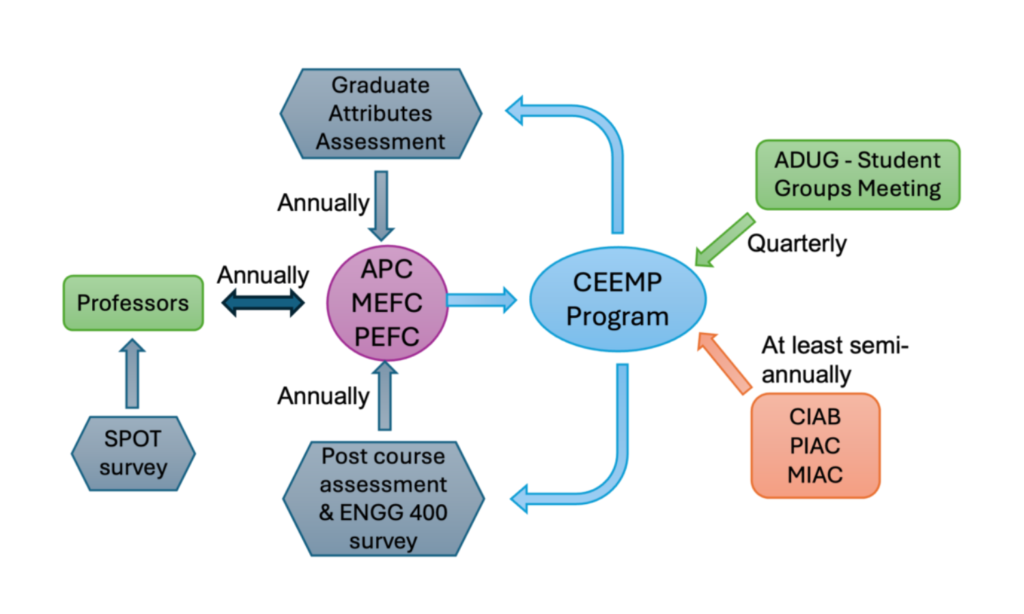Continual Improvement Process (CIP)
Department of Civil and Environmental Engineering
School of Mining and Petroleum Engineering
University of Alberta
It behooves the Educational institutions to be constantly morphing and adapting themselves to societal changes. To that effect, adopting a continual improvement process (CIP) can provide means for gradual improvement of the institution’s systems or upgrading all at the same time. The CIP is felicitously defined by W. Edwards Deming, as a part of the system where organizational goals are assessed regarding the feedbacks from the process and customers. According to the institute of quality assurance, CIP is overtime and endless change with an emphasis on the efficiency of the organization to satisfy its goals and policies. The purpose of CIP is the recognition and lessening of substandard processes with a focus on incremental and persistent steps rather than massive jumps [1].
Each engineering program requires a CIP in order to assure that it stays relevant to the current trends, and its graduates attain knowledge and skills necessary for the evolving job-market. Also, the Canadian Engineering Accreditation Board (CEAB) mandates that each program develops and maintains a CIP that is based on consultation with a wide range of internal and external stakeholders. The CIP process should have conspicuous steps for improvement with a clear timetable. Additionally, CEAB defines twelve key graduate attributes (GAs) that a recent graduate needs to possess upon graduation. Assessing the GAs of graduates not only affirm that program goals are met but also generate essential data that provides essential feedback for the CIP process. Assessing the GAs can be performed utilizing activity-specific assessment surveys addressing one or more indicators for each attribute, student’s self-assessment or third-party reviews. Finally, according to CEAB, each program should provide evidence that the CIP has resulted in enhancement of GAs achievement and/or advances in assessment process [2].
The Office of the Associate Dean of Undergraduate Studies in the Department of Civil and Environmental Engineering, School of Mining & Petroleum Engineering (CEEMP) at the University of Alberta (UofA) developed a CIP that is tailored towards the CEEMP Program. Central to the process is the Academic Planning Committee (APC), which includes faculty representatives from each of the six Civil Engineering subdisciplines, as well as from Mining Engineering and Petroleum Engineering. The committee also consists of undergraduate student representatives and the Curriculum Development Officer. APC is responsible, under the direction of the Associate Dean of Undergraduate Studies, and based on three different channels of input, for proposing updates to the curriculum in the form of renewed curriculum maps, reassessed learning outcomes, and the associated calendar description. The Mining and Petroleum Engineering Faculty Committees (MEFC and PEFC) oversee curriculum updates for their respective programs. Their representatives present these updates to the APC for review and alignment with the broader department goals. The first channel of input is through the GAs assessment tools. The second channel involves the post-course assessment feedback provided by the professors and the feedback from EngG 400 provided by students. These two channels are reviewed and analyzed on an annual basis. The third channel of input is stakeholder consultation. This includes regular meetings between the Associate Dean of Undergraduate Studies and Student Club leaders, as well as industry advisory board and committee meetings (CIAB, PIAC, MIAC), held at the frequencies shown in Figure 1.

Fig 1: CIP developed by the Office of the Associate Dean of Undergraduate Studies in the Department of Civil and Environmental Engineering, School of Mining & Petroleum Engineering
All collected input data will be housed and analyzed by the Curriculum Development Officer at the office of the Associate Dean of Undergrad Studies. The analysis will aim to ensure that the curriculum content and associated GAs assessment are relevant to the skills required by the graduates as identified by the various stakeholders. The GAs assessment will follow the commonly approach of utilizing the 4-tiered rubrics [3, 4]. This includes defining a numerical value between 1 to 4 representing the 4-scales of rubrics, including unsatisfactory, marginal, meets expectations, and exceeds expectations for each graduate attribute indicator. The percentage of each indicator regarding these four scales will be calculated. A target threshold as an intended level of proficiency and a limit as the minimum acceptable level of performance for each indicator will be defined. Indicators with the cumulative percentage below the threshold demonstrate the need for improvement in that particular GA. Process of data collection and program improvement will be continued to assure that all graduates of the civil engineering program are equipped with state-of-the-art knowledge and expertise.
References:
1- https://en.wikipedia.org/wiki/Continual_improvement_process
2- Canadian Engineering Accreditation Board (CEAB). (2023). Accreditation Criteria and Procedures. CEAB, Ottawa, Ontario.
3- Easa, S. M. (2013). Framework and guidelines for graduate attribute assessment in engineering education. Canadian journal of civil engineering, 40(6), 547-556.
4- Spracklin-Reid, D., & Fisher, A. (2014). Curriculum mapping in engineering education: Linking attributes, outcomes and assessments. Proceedings of the Canadian Engineering Education Association (CEEA).